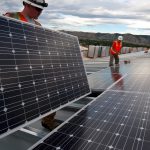EIA: 1 in 4 Households are All Electric
EIA’s most recent 2015 Residential Energy Consumption Survey found that twenty-five percent of United States households nationwide are using only electricity. The increase in the number of all-electric homes is a trend as there has been an increase in each census region over the past decade. Thanks to technological advancements and low-cost natural gas, more and more homes are transitioning to all-electric.
Arizona and New Jersey Homes Among the Costliest to Cool in Summer
While the nationwide average for home cooling costs last summer was $147.82 states like Arizona and New Jersey paid $200-300 more. For Arizona residents, summer cooling costs an average of $476.83 and in New Jersey, $326.65. Whether or not homeowners had their own solar or battery storage systems did not have much effect on the cost, as those with solar systems often overused their HVAC systems than they would otherwise. For states like New Jersey and New York with larger homes to cool naturally have higher cooling costs than the national average per resident.
100% Renewables by 2030 to Cost U.S. Households $4.5 Trillion
A recently published Wood Mackenzie study estimates that switching to 100% renewable energy by 2030 will cost U.S. consumers $4.5 trillion. Plans like the proposed Green New Deal and renewable energy mandates could cost upwards of $35,000 per U.S. household to make the transition, a hefty price that not everyone can afford. To reach goals, renewable energy installation would have to produce more annual capacity each of the next eleven years than what has been installed collectively over the past two decades.
Wisconsin Energy-Efficiency Ranked Among Most Cost-Effective in Nation
Wisconsin’s “Focus on Energy” energy-efficiency was found by a federal study to have achieved the highest rate of energy savings per dollar spent. Accounting for 29 million tons of avoided carbon dioxide, the equivalent of taking 6 million cars off the road a year, the program stands as a leader in energy efficiency. Focus on Energy is currently constructing a new high school with a geothermal energy system, a projected energy savings of 42% a year  other equipment.
other equipment.
Nevada Plans For Largest U.S. Solar Plant
The Nevada utility NV Energy recently announced three new solar projects: Arrow Canyon Solar Project, Southern Bighorn Solar & Storage Center, and Gemini Solar + Battery Storage Project. The proposed projects would have a total generating capacity of 1200 MW and add an additional 590 MW of battery storage to the state. Based on Wood Mackenzie analysts, the Gemini Solar + Battery Storage Project would be the largest U.S. solar project.

